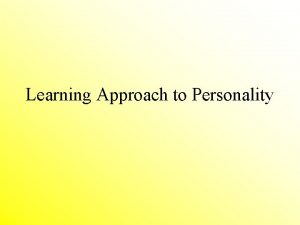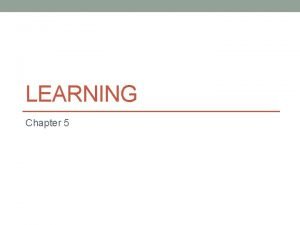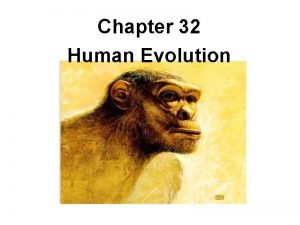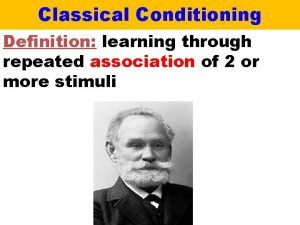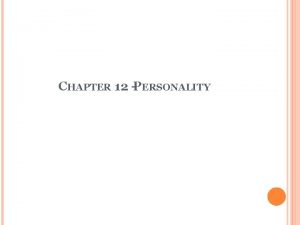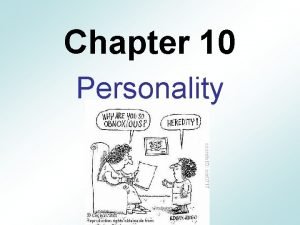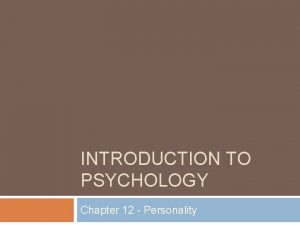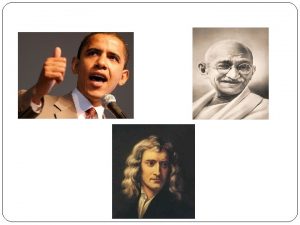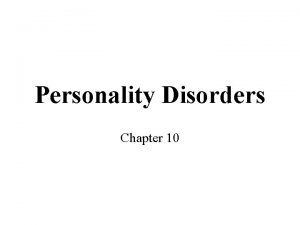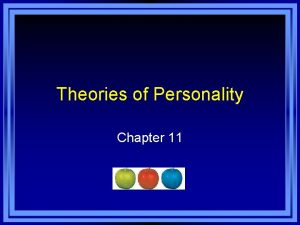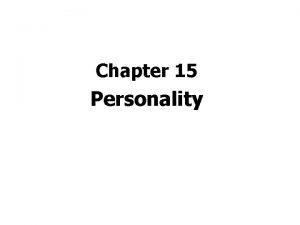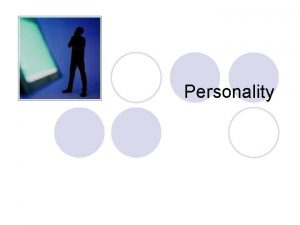CHAPTER 12 PERSONALITY SECTIONS 4 THROUGH 8 LEARNING




















- Slides: 20

CHAPTER 12 PERSONALITY SECTIONS 4 THROUGH 8 LEARNING GOAL FOUR: DISCUSS THE PERSONOLOGICAL AND LIFE STORY PERSPECTIVE.

PERSONOLOGICAL AND LIFE STORY PERSPECTIVES • The personological and life story perspective stresses that the way to understand an individual is to focus on their life story; that is, the aspects that distinguish them from others.

MURRAY’S PERSONOLOGICAL APPROACH • Murray came up with the term personology to refer to the study of the whole person. He believed that in order to understand an individual, the individual’s history had to be understood. • During World War II, Murray was asked to develop a psychological profile of Adolf Hitler. This began what is currently used as criminal profiling. • Murray believed that an individual’s motives are largely unknown to them. • Three unconscious needs have been the focus of current research: the need for achievement, the need for affiliation, and the need for power. • https: //www. youtube. com/watch? v=q 5 hiz. SYi. WIU

THE LIFE STORY APPROACH TO IDENTITY • Dan Mc. Adams developed what is known as the life story approach, which says that all individuals have their own life story that is full of ups and downs. The stories represent memories that make an individual who they are. • Life stories provide an excellent opportunity for the researcher. However, they are very time consuming and difficult. Also, in order for the life story study to be worthwhile, it must tell something more than what could be found in a much easier way.

LEARNING GOAL FIVE: EXPLAIN THE SOCIAL COGNITIVE PERSPECTIVES. • Bandura’s Social Cognitive Theory • Where Skinner saw behavior as being caused by a situation, Albert Bandura saw the individual causing situations, . He postulated that sometimes the definition of the situation itself depends on the individual’s belief about it. • Bandura believed that behavior, environment, and both personal and cognitive factors are all important in understanding personality. He came up with the term reciprocal determinism to describe the way all of these interact to create personality.

OBSERVATIONAL LEARNING • Through observational learning, an individual forms ideas about the behavior of others and then possibly adopts this behavior themselves. • Personal Control- An individual can regulate and control one’s own behavior despite the changing environment. • Self-efficacy is the belief that an individual can master a situation and produce positive outcomes. It determines whether people can even try to develop healthy habits, how much effort they expend in coping with stress, how long they persist in the face of obstacles, and how much pain and stress they experience.

MISCHEL’S CONTRIBUTIONS • Mischel examined the research on trait prediction of behavior and found something missing. He concluded that there was no evidence for cross-situational consistency in behavior. • He believed that personality often changes according to a given situation. His view is often called situationism, which means that personality and behavior often vary considerably from one context to another. • The question is not whether personality predicts behavior, but how and when it does so, often in a combination with situational factors. Individuals select which situations they are in. • Research findings suggest that the more limited a trait is, the more likely it will predict behavior; some people are consistent on some traits, while others are consistent on different traits; and personality traits exert stronger influences when situational factors are less powerful.

CAPS THEORY • The cognitive-affective processing system (CAPS) theory, states that an individual’s thoughts and emotions about themselves and the world affect their interactions with the environment and become linked together in ways that matter to behavior. • It is considered a bottom-up approach, meaning it is consistent with how personality works, not what it is. • It focuses on the way people behave in different situations and uniquely interprets situational features. • CAPS tends to lead to a very specific prediction for each individual in any given situation. (A Problem)

LEARNING GOAL SIX: DISCUSS THE BIOLOGICAL PERSPECTIVES. • There has been a clear association between the brain and personality, noted since the story of Phineas Gage. • New research is focusing on which brain activity is associated with which personality traits.

EYSENCK’S RETICULAR ACTIVATION SYSTEM THEORY (RAS) • Recall that the RAS plays a role in wakefulness and arousal. • Extraverts and Introverts show a different baseline level of arousal in this system. • Extroverts wake up in the morning under-aroused, which requires them to behave in ways that demonstrate extraversion in order to bring their arousal up to its optimal level. • Introverts wake up in the morning over-aroused, which requires them to behave in ways that demonstrate introversion in order to decrease their arousal level to its optimal baseline. • https: //www. youtube. com/watch? v=GDLLDJh. Ftto

GRAY’S REINFORCEMENT SENSITIVITY THEORY • Gray posited that two neurological systems, the behavioral activation system (BAS) and the behavioral inhibition system (BIS), are underlying personality. • Organisms sensitive to rewards are more likely to learn associations between the behavior and the reward and demonstrate sensation-seeking behaviors. • In contrast, organisms sensitive to punishers in the environment will learn such associations and be more likely to avoid such consequences. • The BAS underlies the extraversion trait. • The BIS is involved in avoidance learning and associated with the trait of neuroticism. • https: //www. youtube. com/watch? v=jne. JUgo_t. FQ&list=PL 0 a. Jx. Vntd. O 1 V QF 8 ksr 8 E 31 e 1 u 4 vrc. Ac. NW

THE ROLE OF NEUROTRANSMITTERS • Neurotransmitters have been implicated in the role of personality that fits Gray’s model. • Dopamine is a factor in the BAS or extraversion trait. • Serotonin has a strong link with neuroticism and is implicated in aggressive behavior.

PERSONALITY AND BEHAVIORAL GENETICS • Behavioral genetics is the study of the inherited underpinnings of behavioral characteristics. • Twin studies using identical siblings are often times compared to see what factors of personality are derived from genes and what factors are influenced from the environment. • The role of genetics and personality is largely complex, with the intertwining of environmental and biological influences difficult to tease apart. • Most traits are probably influenced by multiple genes, making the task of identifying specific links very challenging.

EVALUATING THE BIOLOGICAL PERSPECTIVES • The link to biological factors and personality is evident. Through the work of animal learning models, advanced brain imaging, and evolutionary theory a picture of biological influences in personality is emerging. • Biology can be the effect, not the cause of personality. • Whether personality is plastic, or able to change, is an important consideration in how biology impacts the shape of our personality. If personality is “caused” by biological processes, does it mean it is “fixed” or permanent?

PERSONALITY ASSESSMENT LEARNING GOAL SEVEN: CHARACTERIZE THE MAIN METHODS OF PERSONALITY ASSESSMENT. • A self-report test is also called an objective test and directly asks individuals whether specific items describe their personality trait. • An empirically keyed test presents a host of questionnaire items to groups of people that are already known to be different in some central way.

SELF-REPORT TESTS • 1. MMPI • The Minnesota Multiphasic Personality Inventory (MMPI) is the most widely used. The most recent version of the test, the MMPI-2, assesses personality and predicts outcomes. • 2. Assessment of the Big Five Factors • The Neuroticism Extraversion Openness Personality Inventory —Revised is a self-report test geared at assessing the five factor model. It also examines six subdimensions that make up the five factors. These items have face validity, meaning that on the surface they seem to fit the trait in question.

PROJECTIVE TESTS • 1. A projective test is one that presents individuals with an ambiguous stimulus and then asks them to describe it or tell a story about it. They are projecting their meaning onto the stimulus. • 2. The Rorschach inkblot test is a projective test. It uses an individual’s perception of the inkblot to determine their personality. • 3. Thematic Apperception Test (TAT) is a test designed to elicit stories that reveal something about an individual’s personality. It consists of a series of pictures and the person taking the test is asked to tell a story about each of the pictures.

OTHER ASSESSMENT METHODS • 1. Behavioral assessment is based on observing the individual’s behavior directly. It assumes the behavior cannot be evaluated outside of the environment. • 2. When direct observation is not possible then the psychologist may ask the individual to make their own assessment of behavior. • 3. Cognitive assessment in personality evaluation is discovering what thoughts underlie the individual’s behavior.

PERSONALITY AND PHYSICAL HEALTH GOAL EIGHT: SUMMARIZE HOW PERSONALITY RELATES TO HEALTH AND WELLNESS . • Personality can affect the health indirectly by leading to behaviors that are either good or bad. • Conscientious people tend to do all the things they are told are good for their health. • Having a sense of personal control can reduce the experience of stress during difficult times. It can lead to the development of problem-solving strategies to cope with stress. It may also help people avoid health-compromising, risky behaviors. • Self-efficacy is related to success in a variety of positive life changes. Having a can-do attitude is important in solving problems and living a positive, healthy lifestyle. • Optimism is viewed as a matter of how a person explains the cause of bad events. They are due to external, unstable, and specific causes. Optimists generally function more effectively and are physically and mentally healthier than pessimists.

PERSONALITY AND PSYCHOLOGICAL WELL BEING • There is a strong relationship between personality and well-being. Neuroticism is associated with lower levels of well-being, whereas extraversion is related to higher levels of well being. • A person’s assessment of his or her level of positive and negative affects and evaluation of his or her life in general is known as subjective well-being. • Traits are enduring characteristics. States are more acute and time-limited experiences.
 Cuadro comparativo entre e-learning b-learning y m-learning
Cuadro comparativo entre e-learning b-learning y m-learning Chapter 9 conic sections and analytic geometry
Chapter 9 conic sections and analytic geometry How many sections are in the chapter handbook for tx hosa?
How many sections are in the chapter handbook for tx hosa? Chapter 7 conic sections and parametric equations
Chapter 7 conic sections and parametric equations Chapter 9 conic sections and analytic geometry
Chapter 9 conic sections and analytic geometry Through one man sin entered
Through one man sin entered Through and through furcation
Through and through furcation Conversion of timber
Conversion of timber Who wrote night of the scorpion
Who wrote night of the scorpion Learning approach to personality
Learning approach to personality Learning english through social issues
Learning english through social issues Optimal auctions through deep learning
Optimal auctions through deep learning Learning through discovery
Learning through discovery Learning through design and technology
Learning through design and technology Law of effect thorndike
Law of effect thorndike A lifelong process of social interaction
A lifelong process of social interaction Principles of educational technology
Principles of educational technology Learn english cartoons
Learn english cartoons Learning through art: primate diversity
Learning through art: primate diversity Learning through association
Learning through association Learning through discussion
Learning through discussion









